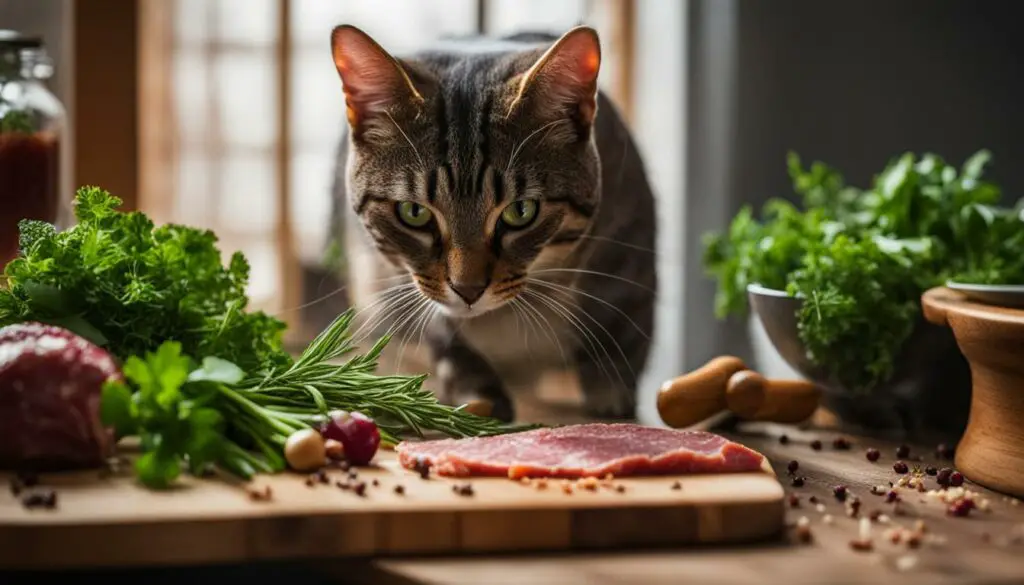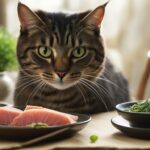Hello, fellow cat lovers! Today, I want to tackle a question that many pet owners have: Can cats eat raw pork? It’s a common query among cat parents, and I’m here to shed some light on the topic. Let’s dive right in!
When it comes to cats and pork, there’s some important information to consider. While cats can indeed eat cooked pork in moderation, raw pork is a whole different story. Raw pork poses several risks to our feline friends, and it’s best to avoid feeding it to them altogether.
Key Takeaways:
- Cats can eat cooked pork in moderation, but it’s not recommended as a regular part of their diet.
- Raw pork should never be fed to cats due to the risk of parasites and bacterial contamination.
- Cats are obligate carnivores and require a diet mainly consisting of meat.
- Pork can provide some nutritional benefits for cats, but it should only be given as an occasional treat and in small portions.
- Commercial cat foods typically provide the necessary nutrition for cats, but additional meat can be a tasty treat.
Are Cats Obligate Carnivores?
Cats are obligate carnivores, meaning their bodies are designed to thrive on a diet primarily consisting of meat. As obligate carnivores, cats have unique nutritional requirements that are best met through the consumption of animal-based proteins. These proteins provide essential nutrients, such as taurine, arachidonic acid, and vitamin A, which are crucial for a cat’s overall health and well-being.
In order to maintain optimal health, cats require a diet that is rich in high-quality animal proteins. These proteins provide the necessary amino acids that cats cannot produce on their own and are essential for various bodily functions, including muscle development, organ function, and the production of enzymes and hormones.
While commercial cat foods are formulated to meet the nutritional needs of cats, adding additional meat to their diet can be a flavorful treat. However, it’s important to ensure that cats receive a balanced diet that provides all the necessary nutrients in the right proportions. It’s always best to consult with a veterinarian to determine the appropriate diet for your specific cat’s needs.
Table: Essential Nutrients for Cats
| Nutrient | Function | Sources |
|---|---|---|
| Taurine | Supports heart health, vision, and reproductive function | Meat, poultry, fish |
| Arachidonic Acid | Aids in the production of prostaglandins for inflammation regulation | Animal fats, especially from poultry and fish |
| Vitamin A | Important for vision, immune function, and healthy skin | Organ meats, such as liver, and fish |
Providing cats with a balanced, protein-rich diet is essential for their overall health and well-being. As obligate carnivores, cats thrive on the nutrients found in meat and require a diet that reflects their evolutionary needs. By meeting their nutritional requirements through a balanced diet, cat owners can ensure that their feline companions lead happy and healthy lives.
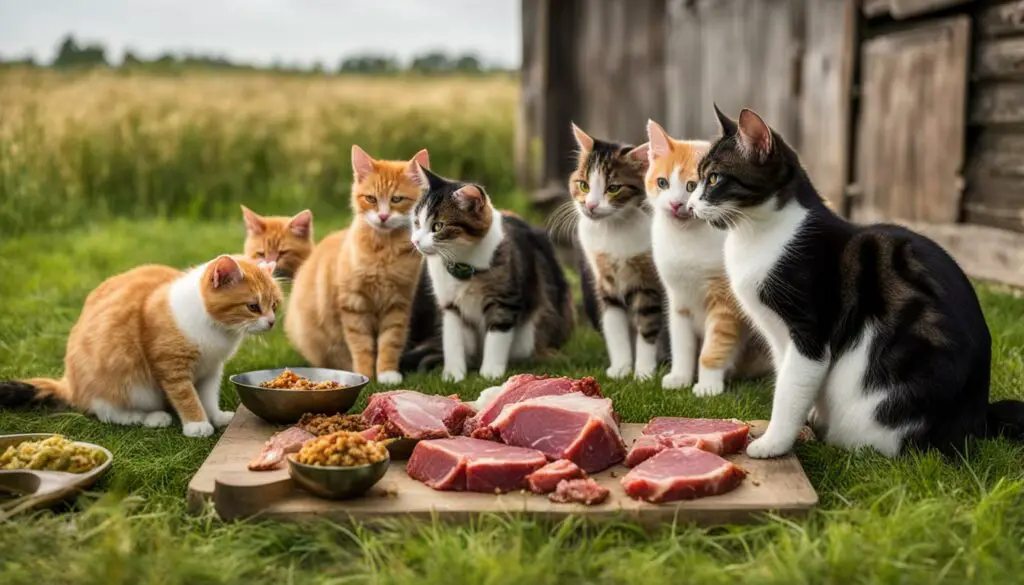
The Nutritional Benefits of Pork for Cats
When it comes to the nutritional benefits of pork for cats, there are several factors to consider. Pork is a good source of protein, which is essential for maintaining muscle mass and overall health in cats. It also contains important B vitamins, including iron, which support healthy red blood cells, energy levels, and brain function. However, it’s important to note that pork should not be a cat’s main source of protein due to its high fat and salt content.
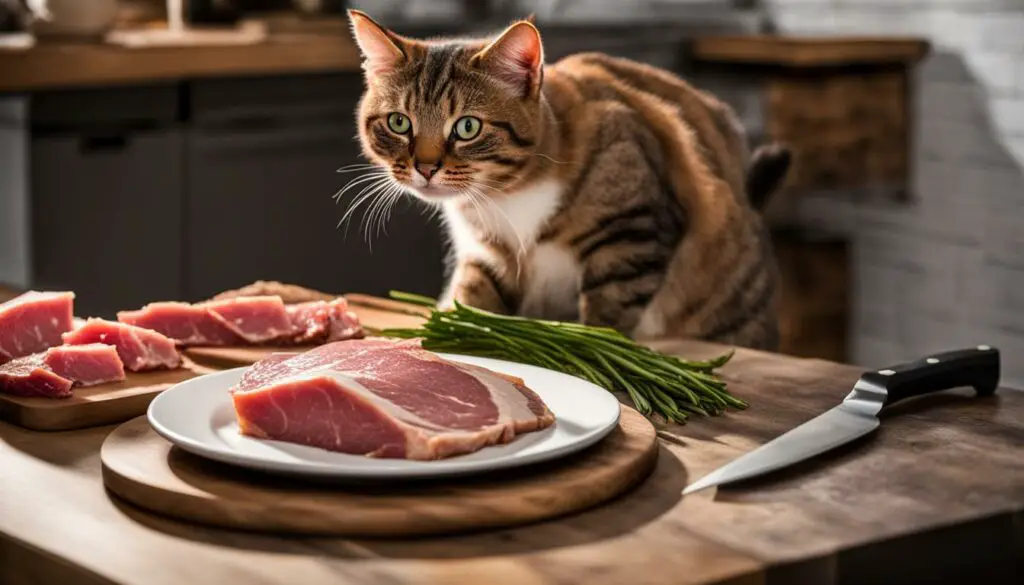
While providing small portions of cooked pork as an occasional treat can be beneficial, it’s crucial to maintain a balanced diet for your feline companion. Cats require a variety of protein sources, such as chicken, beef, and fish, to meet their nutritional needs. These protein sources offer similar benefits to pork without the associated risks. It’s also important to consult with a veterinarian to ensure that your cat’s specific dietary requirements are being met.
Pork Nutritional Composition (per 100g)
| Nutrient | Amount |
|---|---|
| Protein | 26g |
| Fat | 15g |
| Iron | 1.1mg |
| Vitamin B12 | 1.1µg |
While pork can offer nutritional benefits for cats, it’s important to remember that moderation is key. As with any food, overfeeding can lead to weight gain and potential health issues. It’s always best to consult with a veterinarian to ensure that you are providing a balanced and appropriate diet for your furry friend.
Can Cats Eat Raw Pork?
When it comes to feeding cats raw pork, it’s important to consider the potential risks and dangers involved. Raw pork may contain various types of bacteria, including Salmonella, which can cause foodborne illnesses in both cats and humans. Additionally, raw pork can harbor parasites such as Trichinella, which can lead to trichinosis, a disease that affects the digestive system and can cause weight loss in cats. To ensure the safety of your feline companion, it is best to avoid feeding them raw pork.
Foodborne illnesses and parasites are not the only concerns when it comes to raw pork for cats. The quality of the meat itself is also something to consider. The pork should be of high quality, free from any signs of spoilage or contamination. Ensuring proper storage and handling of the raw pork is essential to minimize the risk of bacterial growth. It is always best to consult with a veterinarian before introducing any new food into your cat’s diet.
Instead of raw pork, it is recommended to feed cats cooked pork as an occasional treat. When cooking pork for your feline friend, it should be thoroughly cooked and deboned. Avoid using any seasonings or flavorings, as they can be harmful to cats. Cooked pork should only make up a small portion of your cat’s overall diet, as it is high in fat and salt. Remember, a balanced and nutritionally complete cat food is the best option to ensure your cat receives all the necessary nutrients for their well-being.
| Raw Pork Risks for Cats | Precautions |
|---|---|
| Foodborne Illnesses – Raw pork may contain bacteria such as Salmonella, which can cause food poisoning in cats and humans. | Handle raw pork with care, follow proper food safety protocols, and avoid feeding raw pork to your cat. |
| Parasites – Raw pork can carry parasites like Trichinella, leading to trichinosis in cats. | Consult with a veterinarian and feed your cat a balanced and nutritionally complete diet without raw pork. |
| Meat Quality – Ensuring the raw pork is of high quality, free from signs of spoilage or contamination, is essential. | Source pork from reputable suppliers and maintain proper storage and handling conditions. |
The Risks of Feeding Raw Pork to Cats
Feeding raw pork to cats can pose several risks to their health and well-being. One of the primary concerns is the presence of trichinosis, a parasitic infection caused by the roundworm Trichinella. Cats that consume raw pork that is contaminated with these parasites can experience gastrointestinal issues, weight loss, and other health problems.
Another significant risk is bacterial contamination. Raw pork can be contaminated with bacteria such as salmonella, which can cause food poisoning in both cats and humans. These bacterial infections can lead to symptoms like vomiting, diarrhea, and dehydration in cats.
Furthermore, feeding raw pork to cats can expose them to other parasites like tapeworms, which can also cause digestive problems and compromise their overall health. It is crucial to remember that raw pork poses a choking hazard as well, as cats can easily ingest bones that may cause obstructions in their digestive tract.
| Risks of Feeding Raw Pork to Cats | Consequences |
|---|---|
| Trichinosis | Gastrointestinal issues, weight loss |
| Bacterial Contamination | Food poisoning, vomiting, diarrhea, dehydration |
| Parasites (e.g., tapeworms) | Digestive problems, compromised health |
| Choking Hazard (bones) | Obstructions in the digestive tract |
Considering the risks associated with raw pork, it is best to avoid feeding it to cats altogether. Instead, opt for cooked pork as an occasional treat, ensuring it is thoroughly cooked, deboned, and free from any flavorings or seasonings. By prioritizing their safety and health, you can provide your feline companion with a balanced and nutritious diet that meets their dietary needs without exposing them to unnecessary risks.
Feeding Cooked Pork to Cats
If you want to treat your cat to pork, it should be thoroughly cooked, deboned, and served without any flavorings or seasonings. Cooked pork can be given to cats as an occasional treat in small portions. However, it is important to remember that treats should only make up 10% of a cat’s daily food intake. Cooked pork should be offered infrequently, and it should not be a regular part of their diet due to its high fat and salt content.
Feeding your cat cooked pork can be a way to provide them with a tasty and satisfying treat. However, it is crucial to take certain precautions to ensure their safety and well-being. Here are some guidelines to follow when feeding cooked pork to your cat:
- Thoroughly cook the pork to eliminate any potential bacteria or parasites.
- Remove all bones from the cooked pork before offering it to your cat to prevent choking hazards.
- Avoid adding any flavorings or seasonings, such as salt, pepper, or spices, as they can be harmful to cats.
- Offer cooked pork as an occasional treat, not as a regular part of their diet, to maintain a balanced nutrition plan.
Remember, while cats can enjoy the occasional taste of cooked pork, their main source of nutrition should come from a balanced cat food that meets all their dietary needs. Consult with your veterinarian for specific feeding guidelines and recommendations for your cat’s individual health and dietary requirements.
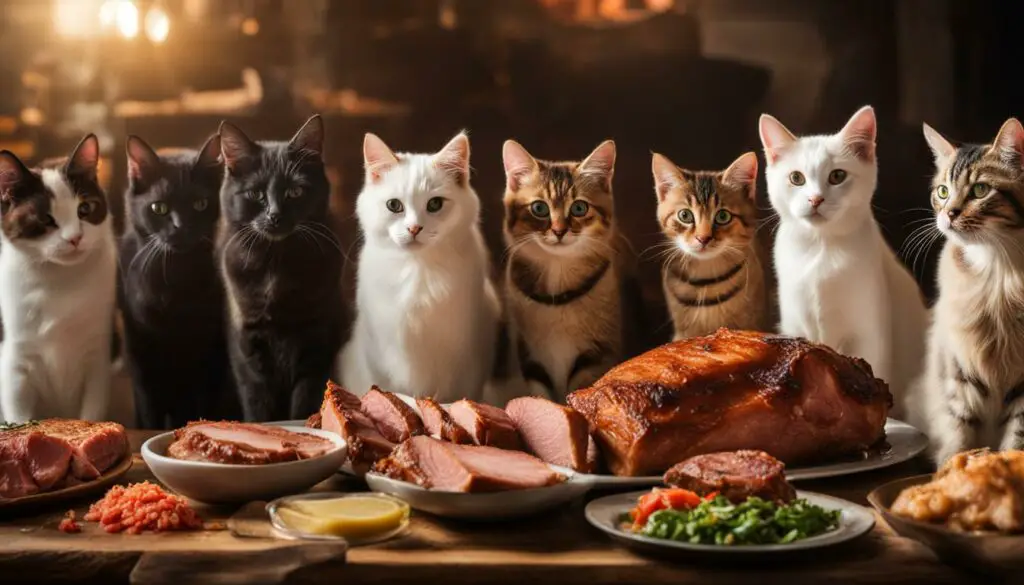
Pork in Commercial Cat Food
When it comes to commercial cat food, pork is not as commonly used as other meat sources such as chicken, beef, duck, or fish. While some cat foods may contain pork, it is not the primary meat source in most commercial cat foods. The main protein sources in commercial cat foods are typically chosen for their nutritional profile and lower fat and salt content compared to pork.
Table 1:
| Meat Source | Common Use in Commercial Cat Food |
|---|---|
| Chicken | Primary protein source in many cat foods |
| Beef | Found in various cat food formulations |
| Duck | Offered in some cat food recipes |
| Fish | Used in many cat foods, especially those for urinary health |
| Pork | Less commonly used in commercial cat food |
While pork can provide some nutritional benefits for cats, it is not as widely incorporated into commercial cat food compared to other meat sources. The decision to include pork in commercial cat food formulations may depend on factors such as market demand, availability, and the specific nutritional needs of cats.
The Potential Health Risks of Pork for Cats
When it comes to feeding pork to cats, there are several potential health risks that pet owners should be aware of. One significant concern is the high fat content of pork, which can contribute to weight gain and obesity in cats. Excess weight can lead to various health issues, including diabetes, joint problems, and heart disease. Additionally, the high salt content in pork can increase the risk of dehydration in cats, especially if they consume it frequently or in large quantities.
Another health risk associated with pork is the potential for pancreatitis. This painful inflammation of the pancreas can be triggered by the consumption of fatty foods, including pork. Cats with pancreatitis may experience symptoms such as vomiting, abdominal pain, and a decreased appetite. It is crucial to monitor your cat’s diet and avoid feeding them foods with high fat content to prevent this condition.
Pork also carries the risk of parasites, both in its raw and cooked forms. Raw pork can contain parasites such as the roundworm Trichinella and the tapeworm Taenia, which can cause digestive issues and weight loss in cats. Properly cooking pork can eliminate these parasites, but it is essential to ensure that the meat is thoroughly cooked and free from any potential contamination.
| Health Risks | Consequences |
|---|---|
| High fat content | Obesity, diabetes, heart disease |
| High salt content | Dehydration |
| Pancreatitis | Inflammation, pain, decreased appetite |
| Parasites | Digestive issues, weight loss |
“Feeding your cat a diet primarily consisting of pork can increase their risk of obesity, pancreatitis, and dehydration. It is important to prioritize their health and choose alternative protein sources that provide similar nutritional benefits without the associated risks.”
Lastly, pork bones can pose a choking hazard or cause digestive obstructions in cats. It is crucial to never feed your cat cooked or raw pork bones, as they can splinter and cause serious harm to their gastrointestinal tract. Always opt for boneless cuts of pork if you decide to offer it to your cat as an occasional treat.
In summary, while pork can provide some nutritional benefits for cats, it is essential to be aware of the potential health risks. The high fat content, risk of pancreatitis, salt content, parasites, and choking hazards associated with pork make it a less ideal choice for a cat’s regular diet. It is crucial to prioritize your cat’s health and consult with a veterinarian to ensure they receive a balanced and nutritious diet.
Assessing the Risks and Benefits of Raw Pork for Cats
When considering feeding raw pork to cats, it is essential to evaluate the risks and benefits carefully. Raw pork can offer some nutritional value to cats, but it also presents potential health hazards such as bacterial contamination and parasites. Cooking pork thoroughly eliminates these risks but may affect some of the nutritional benefits. It is crucial to weigh these factors and consult with a veterinarian to make an informed decision about whether to feed raw pork to your cat.
Raw pork carries the risk of bacterial contamination, including the presence of salmonella, which can cause foodborne illnesses in cats and humans alike. Additionally, raw pork may harbor parasites such as the roundworm Trichinella and the tapeworm Taenia, which can lead to digestive issues and weight loss in cats. Taking the necessary precautions to eliminate these risks, such as proper cooking and handling, can help mitigate these concerns.
“Feeding raw pork to cats can offer some nutritional benefits but also carries the risk of bacterial contamination and parasites.”
Cooking pork thoroughly eliminates the potential health risks associated with raw pork. However, it is worth noting that high-temperature cooking methods may impact the nutritional value of the meat, potentially reducing the overall nutrient content. Despite these considerations, cooked pork can still be offered to cats as an occasional treat in small portions, as long as it is deboned and does not contain any flavorings or seasonings.
Ultimately, when deciding whether to feed raw pork to your cat, it is crucial to prioritize their safety and well-being. Considering the risks and benefits, consulting with a veterinarian, and exploring alternative protein sources can help ensure that your cat’s diet is balanced and appropriate for their specific nutritional needs.
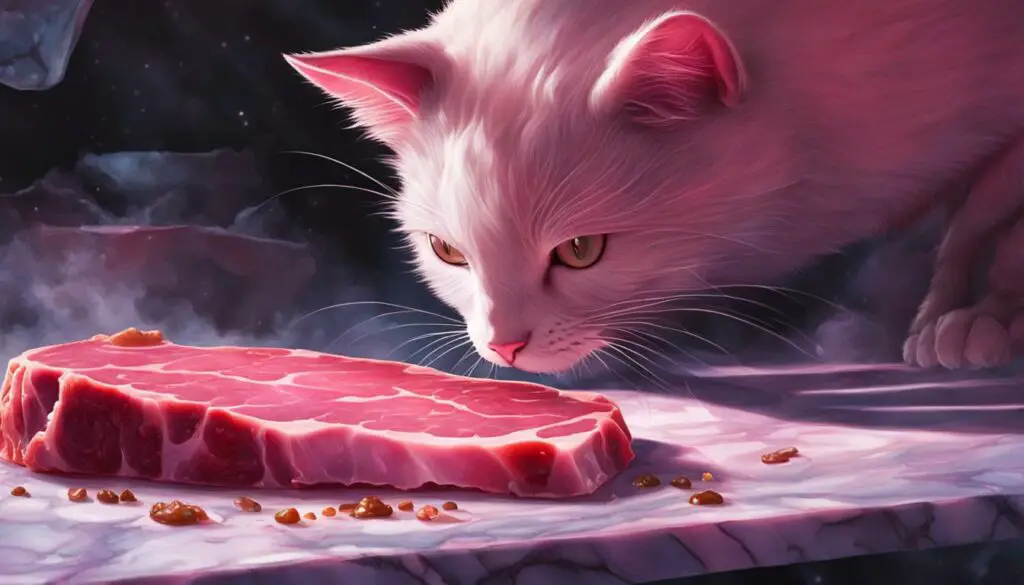
Alternatives to Raw Pork for Cats
When looking for alternative protein sources for your cat, there are several options that can provide the necessary nutrients for their feline health. These alternatives offer a balanced diet and can be a suitable replacement for raw pork.
1. Chicken: Chicken is a common protein source in commercial cat foods and is highly digestible for cats. It is rich in lean protein, vitamins, and minerals that contribute to your cat’s overall well-being.
2. Turkey: Turkey is another excellent protein source for cats. It is lean and easily digestible, making it a suitable option for cats with sensitive stomachs or allergies. Turkey also provides essential amino acids and vitamins.
3. Fish: Fish, such as salmon or tuna, can provide cats with essential omega-3 fatty acids, which promote healthy skin and a shiny coat. However, it is important to ensure that the fish is cooked thoroughly to eliminate any potential parasites.
4. Beef: Beef is a nutrient-rich protein source that can be included in your cat’s diet. It provides essential amino acids, vitamins, and minerals. However, it is essential to feed lean cuts of beef and avoid fatty cuts or excessive seasoning.
| Protein Source | Nutritional Benefits |
|---|---|
| Chicken | High in lean protein, vitamins, and minerals |
| Turkey | Lean protein, suitable for cats with sensitive stomachs or allergies |
| Fish | Provides essential omega-3 fatty acids for healthy skin and coat |
| Beef | Rich in essential amino acids, vitamins, and minerals |
The Importance of Balanced Nutrition for Cats
Ensuring balanced nutrition is essential for maintaining the health and well-being of our feline companions. Cats have unique dietary needs, requiring a mix of proteins, fats, carbohydrates, vitamins, and minerals to thrive. Providing a complete and balanced diet is crucial for cats to receive all the essential nutrients they need.
A cat’s diet should primarily consist of high-quality protein sources, such as chicken, turkey, beef, or fish. These meats offer the necessary amino acids to support muscle development and overall feline health. It is important to choose cat foods that list these quality protein sources as the main ingredients.
In addition to protein, cats also require a moderate amount of fats and carbohydrates in their diet. Fats provide energy and aid in the absorption of fat-soluble vitamins. Carbohydrates, although not essential, can be a source of energy for cats. However, it is important to note that cats have a limited ability to digest and utilize carbohydrates compared to dogs or humans.
Ensuring a cat’s diet includes a variety of protein sources and is nutritionally balanced is crucial for their overall health. This helps prevent nutrient deficiencies and imbalances, which can lead to various health issues. Consulting with a veterinarian for guidance on a cat’s specific dietary needs can ensure they receive the optimal nutrition for a long and healthy life.
| Nutrient | Sources |
|---|---|
| Protein | Chicken, turkey, beef, fish |
| Fats | Chicken fat, fish oil |
| Carbohydrates | Rice, corn, peas |
| Vitamins and Minerals | Vitamin A, D, E, K, B-complex vitamins, calcium, phosphorus |
The Controversy Surrounding Raw Feeding for Cats
Feeding cats a raw meat diet is a topic that sparks controversy within the feline community. Proponents of raw feeding argue that it closely mimics a cat’s natural diet in the wild and can offer potential health benefits such as improved digestion, healthier skin and coat, and increased energy. These advocates believe that a raw meat diet is more biologically appropriate for cats, as they are obligate carnivores.
On the other hand, opponents of raw feeding raise concerns about the risks associated with bacterial contamination, parasites, and nutritional imbalances. They argue that raw meat can contain harmful pathogens, such as salmonella and E. coli, which can lead to foodborne illnesses in both cats and humans. Additionally, raw diets may lack essential nutrients and vitamins that are necessary for a cat’s optimal health.
It is essential to consider both the pros and cons of raw feeding and make an informed decision based on your cat’s specific nutritional requirements, health status, and consultation with a veterinarian. If you choose to feed your cat a raw meat diet, it is crucial to follow proper food safety protocols, including sourcing high-quality meat, practicing good hygiene, and ensuring appropriate storage and handling to minimize the risk of foodborne illnesses.

The Pros and Cons of Raw Feeding for Cats
| Pros | Cons |
|---|---|
|
|
Considering the Safety of Raw Meat for Cats
Feeding raw meat to cats carries inherent risks, including the transmission of meat-borne diseases and zoonotic diseases that can be passed between animals and humans. It is essential to prioritize food safety when handling raw meat to protect both your cat and yourself from potential health hazards.
The table below provides an overview of the main risks associated with feeding raw meat to cats and the importance of following proper food safety protocols:
| Risks of Raw Meat for Cats | Importance of Food Safety |
|---|---|
| 1. Raw meat can contain meat-borne diseases such as trichinosis and salmonella. | 1. Proper cooking methods, such as thorough cooking, can eliminate potential pathogens. |
| 2. Raw meat can carry parasites that can cause digestive issues and weight loss in cats. | 2. High-quality meat from reputable sources should be used to minimize the risk of parasites. |
| 3. Zoonotic diseases can be transmitted to humans through direct contact with raw meat or cross-contamination. | 3. Following raw feeding precautions and practicing good hygiene can prevent the transmission of zoonotic diseases. |
It is important to note that raw feeding for cats is a controversial topic within the feline community. While some proponents argue that a raw diet provides potential health benefits, opponents point out the risks of bacterial contamination, parasites, and potential nutritional imbalances. The decision to feed raw meat to your cat should be made carefully, considering their individual health needs and consulting with a veterinarian.
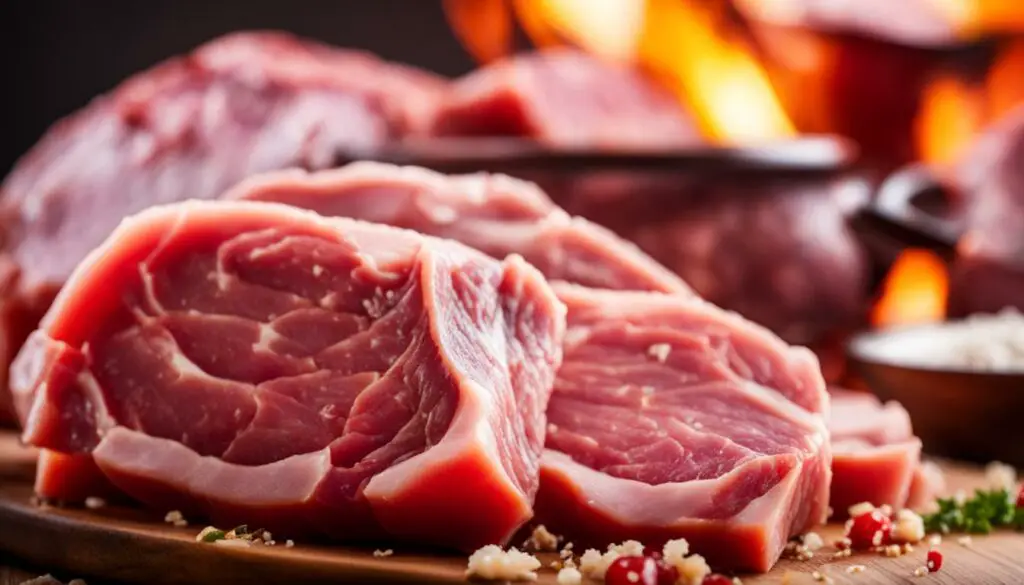
Precautions and Guidelines for Feeding Cats Raw Meat
Feeding raw pork to cats may seem like a natural choice, but it’s important to take precautions to ensure their safety and well-being. Raw meat can carry bacteria and parasites that can pose health risks to both cats and humans. Here are some essential guidelines to follow when feeding raw meat to your feline friend:
- Choose high-quality meat from reputable sources: Ensure that the raw pork you feed to your cat comes from reliable suppliers known for their strict safety standards. This minimizes the risk of bacterial contamination and other potential health hazards.
- Practice safe cooking methods: If you decide to cook the raw pork before feeding it to your cat, make sure it is fully cooked to eliminate any harmful bacteria or parasites. Thoroughly cooking the meat will help ensure your cat’s safety.
- Follow raw feeding precautions: When handling raw pork, it’s essential to follow proper hygiene practices. This includes washing your hands thoroughly before and after handling raw meat, keeping raw and cooked foods separate, and thoroughly cleaning any utensils or surfaces that come into contact with raw pork.
- Monitor your cat’s health: Pay close attention to any changes in your cat’s behavior, appetite, or digestive system after feeding them raw pork. If you notice any signs of illness or discomfort, it’s important to consult a veterinarian.
Remember, while raw meat can offer some potential nutritional benefits for cats, it’s crucial to prioritize their safety. Following these precautions and guidelines can help minimize the risks associated with feeding raw pork to your beloved feline companion.
“Feeding raw meat to cats requires careful consideration and adherence to safety protocols. By sourcing high-quality meat, cooking it thoroughly, and practicing proper hygiene, you can help ensure your cat’s raw meat meals are safe and nutritious.”
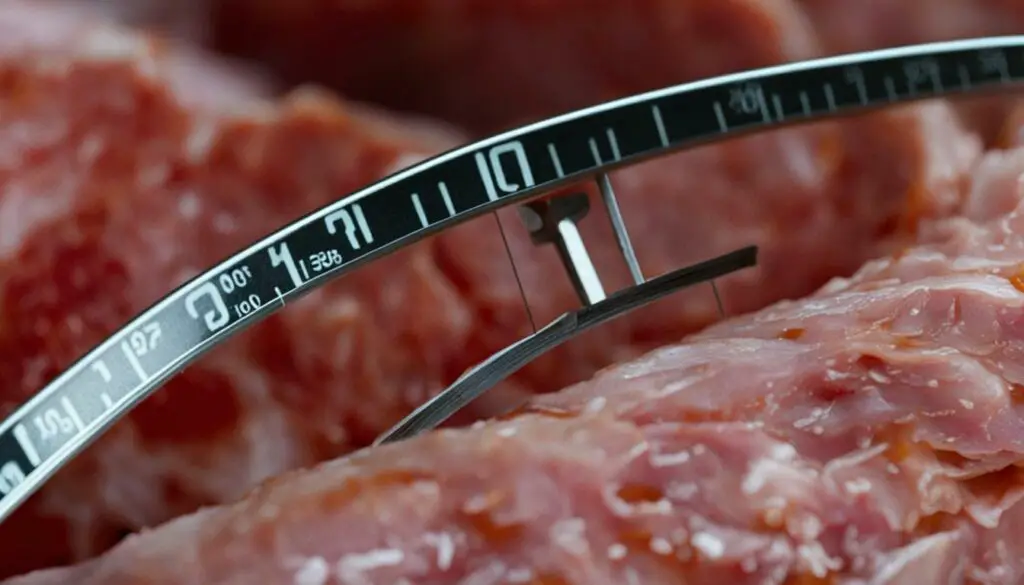
Table: Pros and Cons of Feeding Raw Pork to Cats
| Pros | Cons |
|---|---|
| Provides potential nutritional benefits | Increased risk of bacterial contamination |
| Mimics a cat’s natural diet | Possible transmission of parasites |
| Can be a tasty occasional treat | Requires safe handling and cooking methods |
It is important to note that the decision to feed raw pork to your cat should be made after careful consideration and consultation with a veterinarian. Every cat is unique, and their individual health needs should be taken into account when determining their diet. A balanced and nutritionally complete cat food, whether commercial or homemade, should always be the foundation of their diet. Treats, including cooked pork, should only make up a small portion of their overall food intake.
Conclusion
After considering the risks and benefits, it is clear that raw pork should not be a regular part of a cat’s diet. While cats can eat cooked pork in moderation, the high fat and salt content make it less ideal as a primary protein source. It is important to prioritize a balanced nutrition for your cat, providing them with a complete and balanced cat food that meets all their nutritional needs.
There are alternative protein sources available that offer similar nutritional benefits without the associated risks. Chicken, turkey, beef, and fish are common protein sources found in commercial cat foods. These meats provide the necessary proteins, essential nutrients, vitamins, and minerals that cats require to stay healthy.
If you want to treat your cat to pork, it should be thoroughly cooked, deboned, and served without any flavorings or seasonings. Cooked pork can be given to cats as an occasional treat, but it should only make up a small portion of their diet. Treats should not replace a cat’s regular, nutritionally balanced meals.
Ultimately, it is crucial to prioritize your cat’s health and consult with a veterinarian for guidance on their specific dietary needs. They can provide personalized recommendations based on your cat’s age, weight, overall health, and individual requirements. By making informed decisions about your cat’s diet, you can ensure they receive the necessary nutrition for a happy and healthy life.
FAQ
Can cats eat raw pork?
Cats can eat raw pork, but it is not recommended due to the risk of bacterial contamination and parasites like trichinella and salmonella.
Is pork a good source of nutrition for cats?
Pork can provide some nutritional benefits for cats, including protein and B vitamins. However, due to its high fat and salt content, it should not be the main protein source for cats.
Why is raw pork risky for cats?
Raw pork can carry parasites and bacteria that can cause digestive issues and foodborne illnesses in cats, including trichinosis and salmonellosis.
Can I feed cooked pork to my cat?
Cooked pork can be fed to cats as an occasional treat. It should be thoroughly cooked, deboned, and served without any flavorings or seasonings.
Can I find pork in commercial cat food?
While pork is occasionally used as an ingredient in commercial cat food, it is not as common as chicken, beef, duck, or fish.
What are the potential health risks of pork for cats?
Pork has a high fat content, which can contribute to weight gain and obesity in cats. It also has a high salt content, which can lead to dehydration. Raw pork can contain parasites, and pork bones can pose a choking hazard.
How should I assess the risks and benefits of raw pork for cats?
When considering feeding raw pork to cats, it is important to weigh the risks of bacterial contamination and parasites against the potential nutritional benefits. Consulting with a veterinarian is recommended.
What are some alternatives to raw pork for cats?
Chicken, turkey, beef, and fish are common protein sources in commercial cat food that offer similar nutritional benefits to pork.
Why is balanced nutrition important for cats?
Cats require a mix of proteins, fats, carbohydrates, vitamins, and minerals in their diet to support overall health and meet their nutritional needs.
Is raw feeding a good option for cats?
Raw feeding is a controversial topic with pros and cons. It is important to consider a cat’s individual nutritional requirements and consult with a veterinarian.
How safe is raw meat for cats?
Raw meat carries the risk of meat-borne diseases and zoonotic diseases that can be transmitted between animals and humans.
What precautions should I take when feeding cats raw meat?
Precautions include using safe cooking methods, sourcing high-quality meat, and following raw feeding guidelines to minimize the risk of foodborne illnesses.
Source Links
- https://www.bellaandduke.com/learn/cat-nutrition/can-cats-eat-raw-meat/
- https://cats.com/can-cats-eat-raw-meat
- https://cats.com/can-cats-eat-pork

